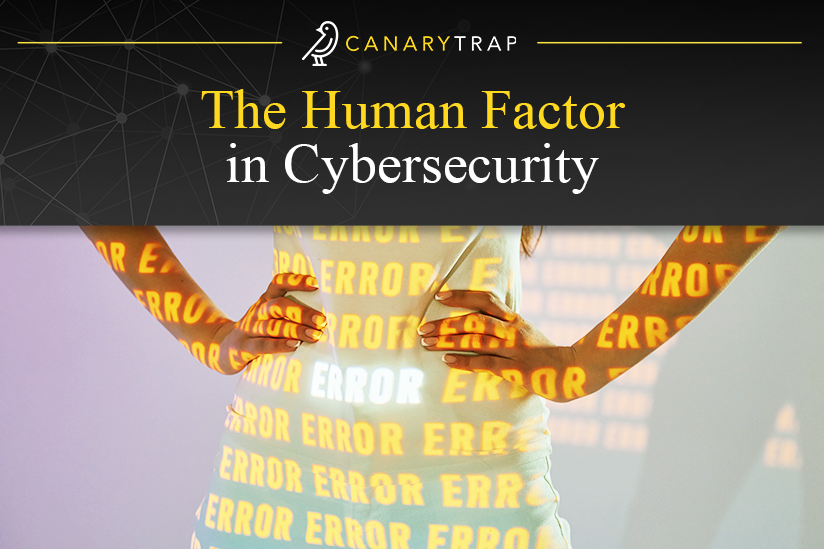The Human Factor in Cybersecurity
- January 26, 2024
- Canary Trap
Nowadays, cybersecurity isn’t merely a concern for governments or large corporations. It’s a personal matter that affects each individual navigating the digital landscape. The introduction of the human factor in cybersecurity signifies the realization that the actions, decisions, and awareness of people play a pivotal role in shaping the overall security posture.
The interconnectedness of our digital lives means that cybersecurity is a shared responsibility. From an unsuspecting click on a phishing email to the use of weak passwords, individual actions can either expose us to cyber threats or contribute to a more secure online environment. Recognizing this symbiotic relationship between individuals and the broader cybersecurity landscape is fundamental to understanding the significance of the human factor.
As we explore this intricate digital realm, it becomes evident that the fortification against cyber threats involves more than just technological safeguards. It’s about acknowledging the human element—the factor that introduces both vulnerability and resilience into the cybersecurity equation. This blog aims to shed light on the profound impact of human actions on cybersecurity, exploring strategies to bolster awareness, impart education, and collectively strengthen our defenses.
The Importance of Cybersecurity Awareness Training
While technological advancements continue to enhance our digital experiences, they also introduce new avenues for cyber threats. The rise of sophisticated phishing attacks, ransomware, and other malicious activities underscores the need for a proactive human defense. This is where cybersecurity awareness training becomes instrumental. This is not a one-size-fits-all endeavor; it’s a personalized journey that empowers individuals with the knowledge and skills to navigate the digital terrain securely.
In an article by Future Processing it was mentioned that “human error is one of the most significant contributors to security risks in the cybersecurity landscape. It refers to mistakes or oversights made by individuals that lead to vulnerabilities or security breaches within an organization’s digital systems, networks, or data. Understanding how human error relates to security risks is crucial for implementing effective measures to prevent and mitigate a potential security incident.”
Consider the scenario of phishing attacks—one of the most prevalent cybersecurity threats. Awareness training educates individuals on how to identify phishing emails, recognize red flags, and avoid falling victim to deceptive tactics. The human vulnerabilities that cyber criminals exploit are often rooted in a lack of awareness. Individuals may unintentionally share sensitive information or use weak passwords, providing entry points for malicious actors, that’s why organizations and institutions can significantly reduce the risk of human-related security incidents if they invest in comprehensive cybersecurity awareness programs.
Moreover, the landscape of cyber threats is dynamic, with new tactics emerging regularly. Cybersecurity awareness training serves as an ongoing process, keeping individuals abreast of the latest threats and best practices. This iterative approach transforms individuals from potential targets into vigilant defenders, contributing to a more resilient cybersecurity posture.
How to Educate People About Cybersecurity
Educating people about cybersecurity requires a multifaceted approach that goes beyond traditional methods. It involves creating a culture where cybersecurity is not perceived as an abstract concept but as an integral part of daily digital life. This cultural shift begins with accessible and engaging education.
Employers play a pivotal role in promoting cybersecurity education among their workforce. Beyond mere compliance training, organizations should foster a culture of cyber awareness. This involves integrating cybersecurity into the company culture and making it a shared responsibility across departments. When individuals understand the relevance of cybersecurity to their roles and personal lives, they are more likely to adopt secure practices consistently.
According to TechTarget, “in crafting a good security awareness training program, companies should emphasize to employees the criticality of protecting the organization and provide an overview of the corresponding corporate policies and procedures that cover how to work securely and who to contact if they discover a potential threat. The security awareness training should be customized to engage employees of all levels, regardless of how long they’ve been with the organization.”
Workshops and online courses tailored to different knowledge levels are effective tools for imparting cybersecurity education. Simulations that mimic real-world cyber threats also provide practical insights, allowing individuals to apply their knowledge in a controlled environment. These interactive experiences enhance retention and empower individuals to respond effectively to actual threats.
In an article published by Forbes, an expert security awareness trainer commented: “Don’t overlook the role that each and every employee plays in helping […] support and enhance cybersecurity efforts. I’ve found that when you shift the focus from ‘blame and shame’ to ‘we’re all in this together,’ you can overcome resistance and complacency. When you’re able to engage with employees in genuine ways, you can build trust. […] Through trust, each of your employees will understand the role they play, individually, in protecting company data and security. It will be something that matters to them, not just to you.”
Effective Cybersecurity Strategies Everyone Needs to Know
Understanding and implementing effective cybersecurity strategies is crucial for individuals and organizations alike, as they try to bolster their defenses against potential attacks. Here are some fundamental cybersecurity measures that everyone should be aware of:
- Strong & Unique Passwords
One of the simplest yet most effective strategies is using strong and unique passwords for every account. This helps prevent unauthorized access even if one password is compromised.
- Enable Multi-Factor Authentication (MFA)
Adding an extra layer of authentication through MFA enhances security by requiring users to provide multiple forms of identification, typically through a smartphone or email.
- Keep Software and Systems Updated
Regularly updating software, operating systems, and applications is crucial. These updates often include security patches that address known vulnerabilities.
- Be Skeptical of Emails and Links
Phishing attacks often rely on deceptive emails and links. Be cautious when clicking on links or downloading attachments, especially if the email seems suspicious or unexpected.
- Secure Personal Devices
Cybersecurity isn’t limited to work devices. Ensuring that personal computers, smartphones, and other devices have security measures in place is essential for comprehensive protection.
- Educate Yourself Continuously
Cyber threats evolve, and staying informed is key. Take advantage of online resources, webinars, and courses to continually educate yourself on the latest cybersecurity trends and best practices.
- Keep Software Updated
Regularly update operating systems, applications, and antivirus software to patch vulnerabilities and enhance security.
- Use a Virtual Private Network (VPN)
When accessing sensitive information over the internet, employ a VPN to encrypt data and ensure a secure connection.
The Impact of Cybersecurity Training
Cybersecurity training goes beyond merely imparting knowledge; it has a profound impact on individuals and organizations. An essential aspect of cybersecurity education is explaining the ‘why’ behind security practices. It’s not just about following rules; it’s about understanding the potential consequences of negligence.
Whether it’s the financial implications of a data breach, the loss of personal information, or the broader impact on organizational reputation, individuals need to comprehend the real-world implications of their actions. By investing in comprehensive training programs, several positive outcomes can be realized, including:
- Risk Mitigation
Training equips individuals to recognize and mitigate potential risks. With a heightened awareness of cyber threats, employees become a proactive line of defense.
- Improved Incident Response
In the event of a security incident, well-trained individuals can respond effectively, minimizing the impact and preventing further escalation.
- Cultivating a Security Culture
Cybersecurity training fosters a culture of security within organizations. When cybersecurity becomes a shared responsibility, everyone contributes to maintaining a secure environment.
- Reduced Vulnerability
Educated individuals are less likely to fall victim to common tactics like phishing or social engineering, reducing the overall vulnerability of the organization.
- Reduction in Security Incidents
Track and analyze the decrease in security incidents after implementing cybersecurity training to demonstrate its effectiveness.
- Improved Incident Response
Evaluate how cybersecurity training enhances the organization’s ability to respond effectively to potential threats.
James Mackay, COO of MetaCompliance notes that “When thinking about putting together a Security Awareness Training program for your workforce, bear in mind that most people spend very little, if any, time thinking about this issue. Cyber security is a tough subject to make interesting. However, it’s the responsibility of the organization to make its security communications palatable and even enjoyable, if possible, for its employees. Obtaining user participation in your cyber awareness programs is one of the key measures of success.”
In Conclusion
The human factor in cybersecurity is both a potential vulnerability and a powerful defense. Therefore, the importance of cybersecurity awareness training cannot be overstated. In our interconnected digital world, where the next cyber threat could be just a click away, investing in cybersecurity education is an investment in the resilience of our digital society. The impact of cybersecurity training goes beyond the individual, extending to the entire organization. A well-informed workforce becomes a collective shield against cyber threats, contributing to risk mitigation, improved incident response, and the cultivation of a robust security culture.
As technology advances and cyber threats become more sophisticated, continuous education is the key to staying ahead of potential risks. The evolution of cybersecurity awareness training must align with the ever-changing threat landscape, ensuring that individuals and organizations remain vigilant and well-prepared. By making education accessible, engaging, and integrated into daily life, we empower individuals to be proactive contributors to a cyber-resilient society.
SOURCES:
- https://www.future-processing.com/blog/the-human-factor-in-cybersecurity-the-greatest-challenge-part-i/
- https://www.techtarget.com/searchsecurity/definition/security-awareness-training
- https://www.forbes.com/sites/forbesbusinesscouncil/2023/04/26/cybersecurity-and-the-human-factor-what-is-each-employees-role/?sh=720afc7e7f13
- https://www.metacompliance.com/blog/cyber-security-awareness/why-is-cyber-security-awareness-training-important

